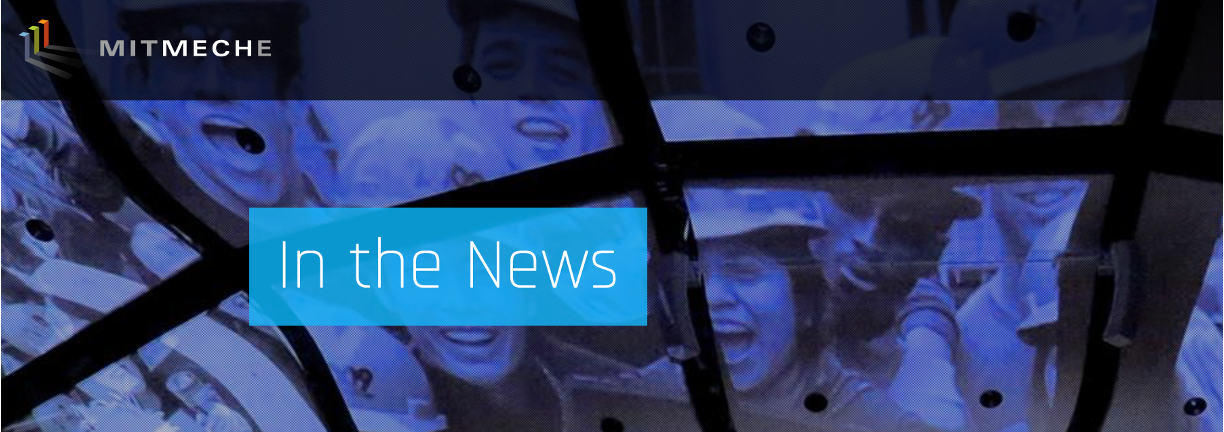Changes to the technological landscape, and to the needs of industry and society, are rapidly expanding the field of mechanical engineering into new areas, driving increased interdisciplinary collaboration, and even yielding new specializations.
“We are continuously pushing the boundaries of our own fields, and redefining what mechanical engineering is,” says Faez Ahmed, d'Arbeloff career development assistant professor of Mechanical Engineering.
Across MechE, faculty and staff are engaging in cutting-edge research at the frontiers of a new vision for mechanical engineering, with teaching and exploration at the intersection of engineering and physics, math, electronics, biology, computer science, and many other fields of study. From the nanoscale to the macroscale, across communities, climates, regions, and geographies, and from the ocean floor to the far reaches of space, the incredible breadth of work underway in MechE is transforming ideas and insight into progress.
“The classical mechanical engineering department that you’re thinking of might have cars, might have steam engines – we have all of those things, but we go so far beyond that,” says Anette (Peko) Hosoi, Pappalardo Professor of Mechanical Engineering.
MIT Sports Lab researchers test athletes’ visual and vestibular systems using a VR headset and software from Prism Neuro. Combined with proprioceptive testing, these devices detect athletes’ movement control abilities, predicting performance and risk of injury. Credit: John Freidah
Sensory processing in sports
Close your eyes, extend your arms, and bring one finger to touch the tip of your nose. The ability to complete this or similar tasks, aided or unaided by sight, is owed to a sensory concept called proprioception. Proprioception involves a variety of complex sensations that allow you to sense the position and movement of your joints, along with the length of stretch in your muscles. These sensations create awareness of your body's positioning.
“Proprioception, basically, is ‘how well do you know where your limbs are,’” explains Hosoi, co-founder of the MIT Sports Lab. “If you have poor proprioception, you’re more prone to injury and, when you’re tired, stressed or sick, proprioception is one of the first thing your brain lets go of.”
Hosoi’s core research interests bring together fluid dynamics, bio-inspired design, and sports data and technology to tackle problems at the intersection of biomechanics, applied mathematics, and sports. Mixing experimental work, numerical simulation, and theoretical analysis, and combining elements of engineering design and mathematical optimization, her work has been used to guide the engineering design of robotic swimmers, crawlers, burrowers and other mechanisms.
Understanding proprioception has applications in robotics, AI, and other mechanical designs, and of course, for keeping athletes healthy and at the top of their game. In a study aimed at understanding whether there are times during the semester when their proprioceptive ability might be lowered, Hosoi and her team are working with MIT varsity athletes to measure proprioceptive abilities.
The measurements are made in collaboration with PrismNeuro, a company focused on advanced human performance and founded by MIT alums. One part of the experiment is eye tracking, the other involves having the athlete place their feet on a tilt plate with a stopper that moves the plate to random positions. The athlete is then asked whether the plate tipped a little or a lot, and the team measures how well they perceive the angle of their foot.
“We measure throughout the semester to understand times when proprioceptive ability is low, which are times when the athletes would be more prone to injury,” Hosoi says. “That’s information we can give back to the coaches and say ‘hey looks like everyone is really stressed out with midterms right now, maybe go easy on them’ – the coaches have been really receptive.”
Research in the MIT Sports Lab seeks to improve athletic performance and equipment, advance understanding, and create actionable insights. Other projects underway involve a study to better understand possible differences between men’s and women’s soccer, a data-informed look at judging in aesthetic sports, like gymnastics, martial arts, or BMX, and studies of the physical performance of professional athletes to determine how good they are at making decisions on the court.
“It’s hypothesized, but not known, that women’s soccer is different [from men’s soccer],” says Hosoi. What is known, she says, is that women suffer from more anterior cruciate ligament (ACL) tears than men, presumably from different stresses. “We can we take tools that have been developed for fluid dynamics and turbulence to quantify the differences, then see if that translates to different stresses on the body.”
Using an accelerometer and gyroscope built into the sole of the cleats of MIT men’s and women’s soccer, MIT Sports Lab researchers are trying to better understand what is guiding players’ motion on the field. “Women’s sports equipment is typically designed via ‘shrink it and pink it,’” says Hosoi. “Understanding of the mechanics and the flow of the game instead, can translate into better equipment design – and, perhaps, fewer injuries.”
[from meche.mit.edu]




